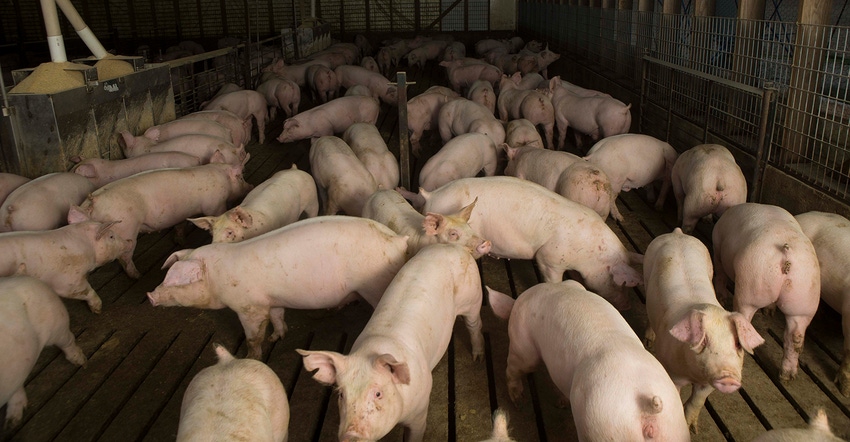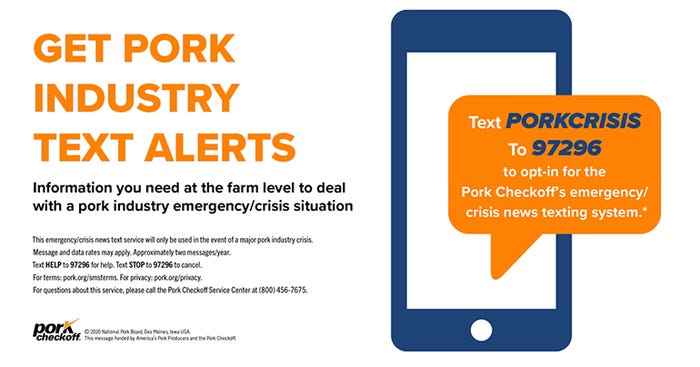Herd vet, animal health officials, NRCS and DNR personnel need to be involved in the process.

Between pork processing plants shutting down completely or slowing down line speed due to COVID-19 affecting plant workers, producers with nowhere to haul their market-ready hogs are looking at all alternatives to ease the situation.
"When you look at agriculture as a whole and the effect on agriculture, and especially on our pig farmers, what we're facing today from animal care and challenges the likes of which we have never seen before, and I hope we never see again," says Dave Pyburn, National Pork Board chief veterinarian. Animal welfare concerns are becoming very real for producers who cannot move market hogs. "Our farmers are then faced with decisions on their farms. They are doing what they can to slow down growth of those animals through change of diets. They're doing what they can to get space in their barns to allow them to delay marketing for as long as they can."
Even with those measures, there will come a point when "animal welfare issues become real in that barns become overcrowded because animals are so big," Pyburn says. "We've got animals then that can't get up to the feeder, can't get to the water. Mobility becomes an issue for the animals moving around the barn and that leads to aggressive actions, and it's a real animal welfare issue."
When producers get to that point, exhausting all other options of slowing down the hogs' growth, using empty sick pens for overflow hogs, it is then that producers get to a decision of last resort.
When/if producers get to the point that euthanasia is the only option left, Pyburn says producers should not venture down that road alone.
Pyburn points out that the American Veterinary Medical Association has species-specific guidelines for the euthanasia of farm animals, segregating them into "preferred" and "permitted" methods of euthanizaing swine. Preferred methods of hog euthanasia include gunshot, penetrating captive bolt, electrocution or carbon dioxide. Under the "permitted" column, producers can use ventilation shut down or sodium nitrite which can be added to the feed or water.
"Not pleasant subjects to have to deal with today, but it is something that our producers, it's very real for them and they're having to address it," Pyburn says.
Once it's determined that euthanasia will take place, producers need to develop a plan that is best for their respective farm, there is no one-size-fits-all across the U.S. swine industry. That plan needs to be done in concert with the herd veterinarian. The next call should be to the state animal health official for further guidance, he says.
In addition to finding the euthanization plan that works best for your farm, Marguerite Tan says each farm also needs to devise a disposal plan that is specific to each farm.
Tan, NPB directors of environmental projects, says "it's very important because of our commitment to protect the environment that we want to make sure that disposal is done in an environmentally protective way."
There are five methods of disposal: burial, incineration, landfilling, rendering and above-ground composting. "What an individual producer chooses to do is really dependent on the governing rules and regulations of where they are located as well as their specific situation," she says.
Just as working with the herd veterinarian is important in devising the proper euthanization plan, working with the herd veterinarian is equally important in devising a disposal plan. Then Tan says producers should be in touch with the local Natural Resources Conservation Service office to coordinate with a staff engineer to identify the best disposal method for that farm. The NPB provides producers with an NRCS field office locator on its COVID-19 resource page.
"NRCS will have an engineer who will not just work them (producers) through figuring out what the best disposal option is for that person," Tan says, "but also be able to walk them through the Environmental Quality Incentive Program to potentially be able to obtain funding for a disposal."
Producers will need to submit an application, as well as needing to receive a waiver from the NRCS prior to proceeding with any euthanasia. "They need to contact their NRCS field office prior to doing any euthanasia of animals and make sure all of their ducks are in a row to get that process started," Tan says. She adds that NRCS offices are set up to act quickly so producers aren't left waiting.
State departments of Natural Resources should also be involved in the process to make sure proper protocols are being followed in the disposal of euthanized animals.

In addition to the plethora of resources the NPB has available for producers, NPB Assistant Vice President of Communications Cindy Cunningham says producers also need to be aware of a call center producer can access, "designed for producers to come in and ask questions that they may have about anything that's going on right now." That call center may be accessed by calling 800-456-7675.
Cunningham also reminds producers of the NPB crisis text alert service, encouraging them (if they haven't already) to sign up for the service "so that you can get a text anytime there is a significant change in what's going on or materials that you may need on your farm." Sign-up is easy, simply text porkcrisis to 97296.
About the Author(s)
You May Also Like



